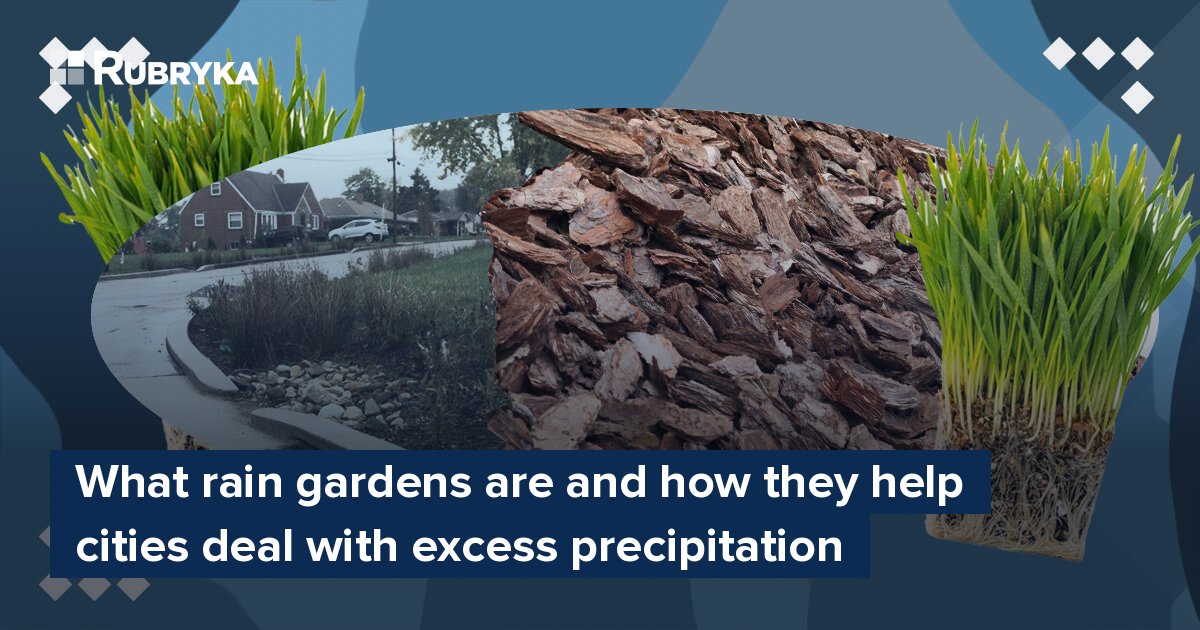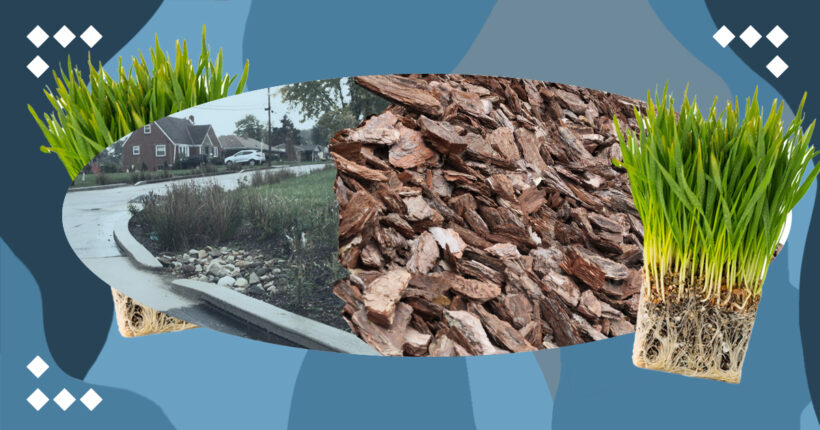
What is the problem?
On June 12, more than half of the monthly precipitation rate fell in Kyiv. According to the city administration, this downpour was the largest in terms of precipitation in 30 years. But bad weather affected not only the capital. Reports of flooded streets, paralyzed traffic, and broken trees also came from other populated areas of Ukraine.
What is the solution?
Rain gardens could be one solution that allows cities to deal with excess precipitation caused by climate change.
Rubryka explores what rain gardens are, what benefits they can bring to the city and whether it is possible to arrange such a garden just in the yard of your high-rise building.
How does it work?
What are rain gardens?

An example of a rain garden. Photo: Pittsburgh Water and Sewer Authority
A rain garden is an artificial recess in the terrain designed to accumulate and absorb excess rainwater. It can look like a sunken flower bed planted with moisture-loving and heat-resistant perennial plants or simply a grass cover with well-drained soil. It all depends on what function the rain garden should perform directly in this or that area.
Rain gardens, as a point landscape solution, allow not only the accumulation of rainwater but also purification by filtering out sediment and pollutants, contribute to air purification and humidification, as well as normalize the local microclimate.
Rain gardens also have an aesthetic function because they can be full-fledged green spaces on city streets, parks, and yards. In addition, examples from other countries show the economic benefit of such structures because arranging drainage channels is cheaper than installing a system of curbs, sidewalks, and ditches.
Foreign experience
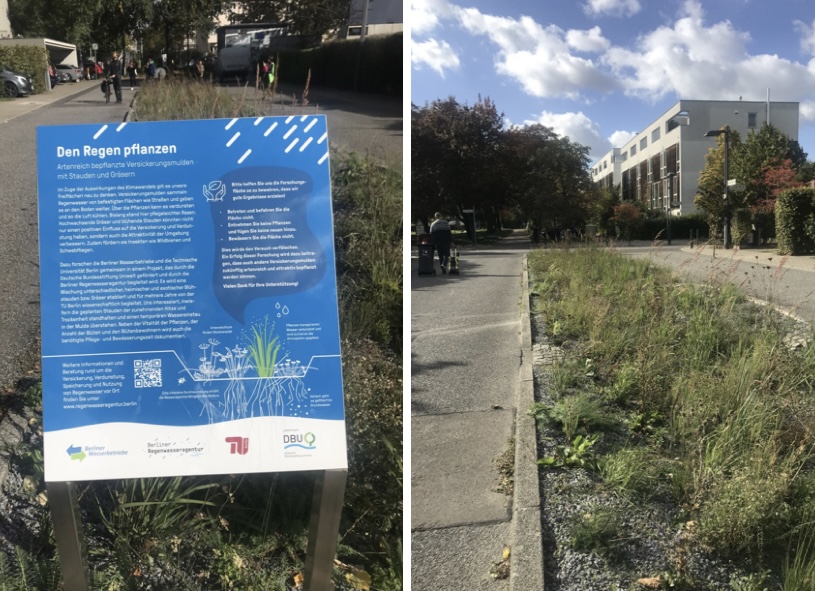
Rain garden in Berlin. Photo by Mariia Golyuk
Rain gardens are not new and are quite a widespread solution worldwide. They are one of many solutions that help cities adapt to climate change. Rain gardens can be seen in Germany, Denmark, Poland, Sweden, and other countries.
Solutions such as rain gardens, green roofs, infiltration trenches, bioplateaus began to gain popularity when the professional community realized that climate change is becoming more acute and cities need new ideas and solutions to improve the situation. "We communicate a lot with our European colleagues and know that European cities have the same problem as we do — flooded streets after rains and floods. Simply because they have the opportunity to put it into practice more intensively, work on strategic documents and concepts, increase the number of water-permeable areas, residents feel the effects less there because the consequences are weaker," says Rivne landscape architect Mariia Golyuk.
For example, Sweden's largest rain gardens were created in Gothenburg in 2015 near the Kviberg multi-sports arena. During construction, 500 parking spaces were arranged around the complex. To deal with rainwater flowing into the parking area, approximately 5% of the total area has been used for rain gardens, which both purify and store rainwater.
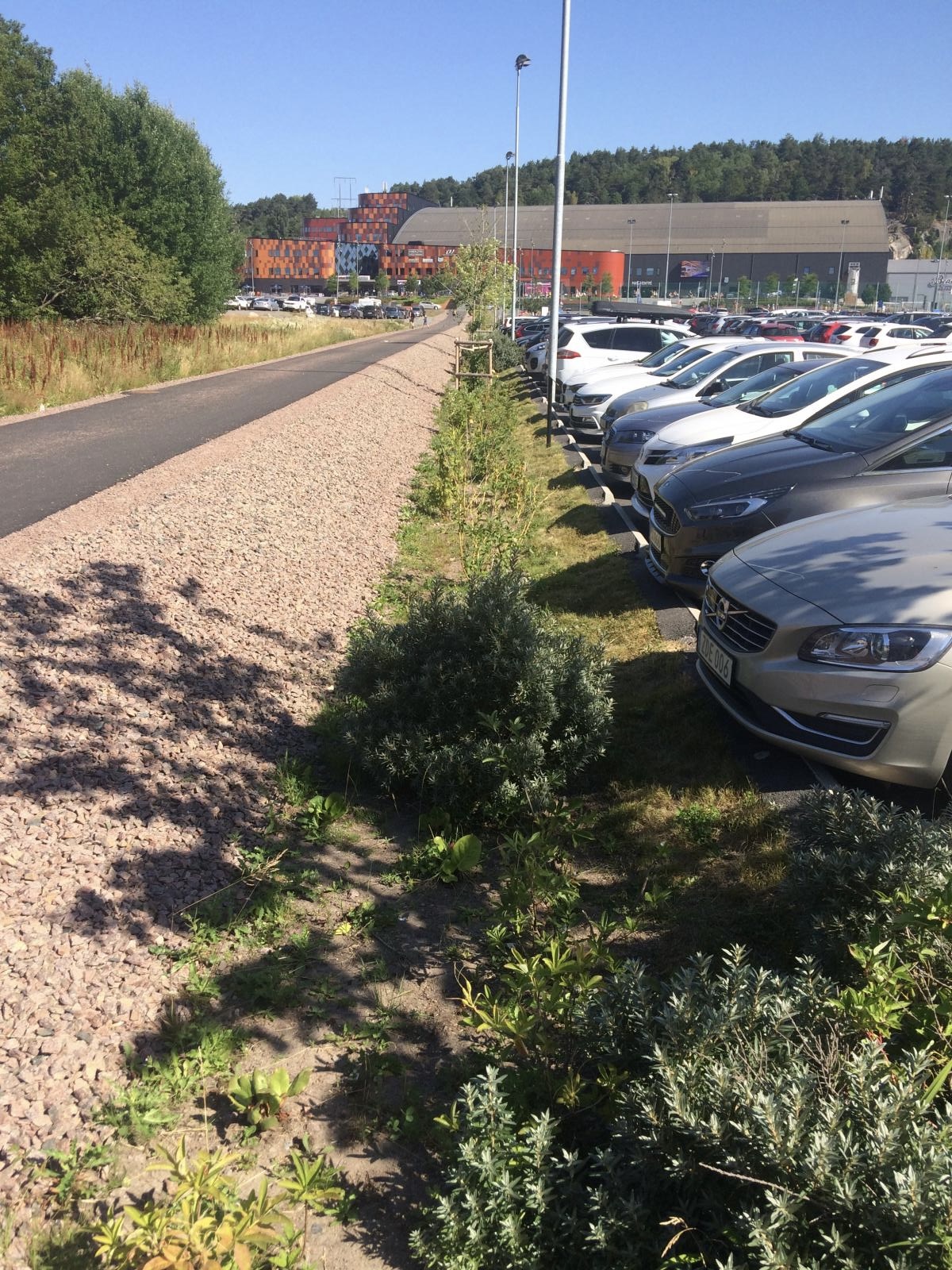
Rain garden in Gothenburg. Photo: una.city
In 2022, a rain garden was installed along the sidewalk of one of the city's old streets in Liverpool, UK. It turned a harsh, "uninspiring" street into a miniature green oasis.

A three-level rain garden in Liverpool. Photo: unalab.eu
The Gdynia Rain Garden project encourages Gdynia (Poland) residents to collect rainwater and demonstrates its importance in the urban environment.
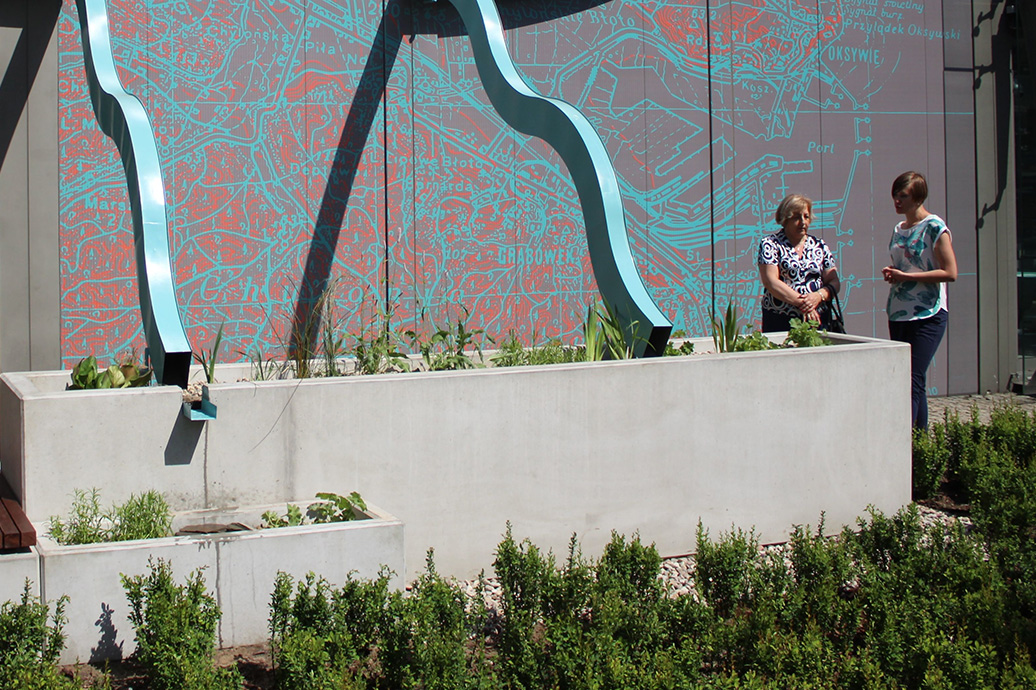
Rain garden in Gdynia. Photo: innovationinpolitics.eu
In general, the systems of such buildings can be quite different:
- accumulative (if we talk about collecting water for reuse);
- simply infiltration (without reservoirs), when water collects in a recess and slowly seeps into the soil;
- overflow, in the form of a cascade of rain gardens formed at different levels. In cascading systems, special obstacles are often added to reduce the flow rate of excess water to the sewer, which the garden will not be able to accumulate in the event of a heavy downpour. Children really like such cascades because they are a whole system of outdoor play. They are also interesting to watch.
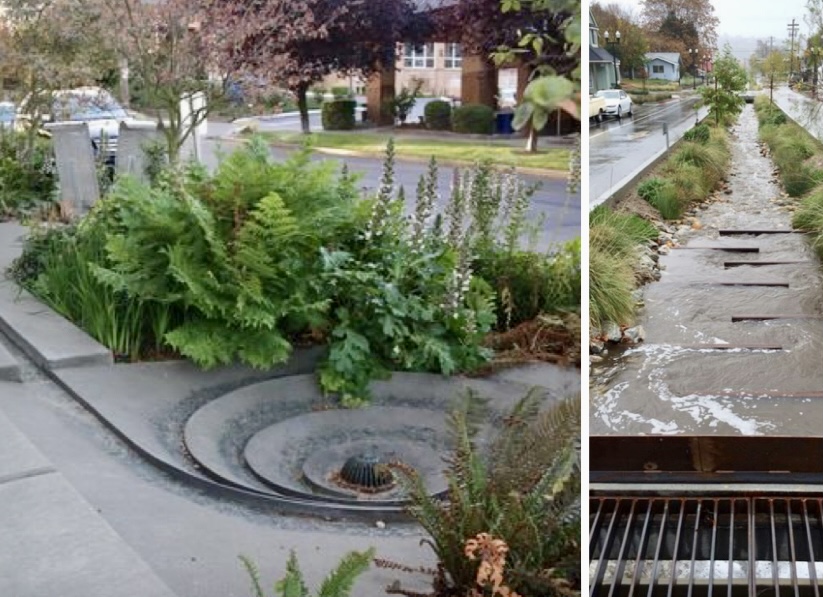
Cascading rain gardens. Photo: Pinterest
Rain gardens in Ukraine
The main task of rain gardens is to catch some portion of rainwater, accumulate it, and filter it directly into the soil in that place or delay it for a certain period while reducing the current load on the city sewage system. For example, Rivne has no separate storm sewer system, so all rainwater enters the domestic sewer system during downpours.
It is obvious that the worn-out system, built in Soviet times, is not ready for such loads and was not designed for them. Recently, precipitation rates have increased significantly, as has the household load on sewage systems due to the city's development.

Rain garden in Rivne. Photo: Garden of Stories in Rivne
In 2022, in Rivne, with the participation of Golyuk, activists, volunteers and local entrepreneurs set up a space with a rain garden system. The rain garden in Rivne has been successfully implemented for two years. The water accumulated thanks to the drainage system and did not stagnate in puddles and flood the territory as it had before. Bushes and flowers planted by volunteers have grown. Unfortunately, in the spring of 2024, when the utility services repaired the access road, the green location, created by caring people, was significantly damaged.
However, activists did not give up. They restored the drainage hole, which was filled with construction debris. Meadow flowers were sown again. They also sent a complaint to the State Environmental Inspection.

Rain garden in Kyiv. Photo: KMDA
Yuliia Yevtushenko, landscape architect at Archimatika, says that environmental friendliness and aesthetics are probably the most important things that the arrangement of rain gardens can bring to the city.
"In Ukraine, we are just beginning to integrate such solutions into the urban planning. Our first experience and indeed an experiment was the rain garden in the Faina Town residential complex. We simulated a river bed, combining just the right rain garden system and natural landscape. During the rains, the stream fills with water and holds it for some time, making the area very natural and attractive. Selected plants passed the test successfully. We plan to implement and promote similar ecological ideas in the future," says Yevtushenko.

A rain garden in the Faina Town housing complex in Kyiv after a downpour. Photo: Archimatika
The Archimatika rain garden successfully withstood the downpour that fell in Kyiv on June 12.
"And for us, it was a real discovery that the rain garden became another playground for the little ones. As it turned out, we created a space where children can interact with plants, water, and natural materials," shares Yevtushenko.
Is it possible to make a rain garden near your house or apartment building?
As Ivan Abramenko, the architect and head of Archimatika's master plan department, notes, you can technically set up a rain garden anywhere in the city, even near your house or a high-rise building. However, it is important to consider several "buts".
- First of all, there must be a project for this object.
- The second problem is the connection to the storm sewer system.
- The third problem is the violation of landscaping.
- To carry out construction work, it may be necessary to obtain a permit from the National Police, as construction machinery will most likely be used.
After obtaining all permits and the project in hand, the site is fenced off, and a pit is dug for the rain garden. The next stage is laying the drainage system and connecting it to the storm sewer network. The final stage is decoration. As a rule, various plants resistant to short-term flooding and dry periods are selected for rain gardens.
In rural areas, it will be easier. There is hardly a rainwater drainage system there, so the water in the rain garden will be filtered through the drainage.

A rain garden near a private house. Photo: seattletimes.com
A rain garden can be organized on your private plot, for example, in the garden. At the same time, you also get an engaging area that will turn into a lake during a downpour. But it will not be possible to arrange such a green location just anywhere, warns Golyuk. Certain technical points need to be considered before implementing the idea of your own rain garden. A rain garden should be placed so that it fulfills its function:
It should be the lowest point on the terrain so that water can get there by gravity.
An analysis of the soils is needed. The soil needs good drainage properties, and if this is not the case, then such a garden will be of little benefit.
Also, if you want a rain garden somewhere close to a building or some structure, you need to consider whether it will not harm the structural properties of the foundations.
Of course, it is important to choose the right structural composition and calculate the garden, determining the volume of water that you need to accumulate. If you have a limited area of the plot, how much precipitation will it be able to absorb?
How to care for a rain garden
- Choose the right plants. They should be well adapted to your climate and soil type. Milk thistle, astilba, irises, various sedges, and cereals can be used. Add wild plants to help beneficial insects survive.
- After planting the plants, water them regularly until they take root. In the future, watering is necessary only in case of prolonged drought. Rain gardens are designed to absorb rainwater, so they do not need constant watering.
- Remove weeds regularly so that they do not interfere with plant growth or spoil the garden's appearance. Use organic fertilizers or compost.
- Remove fallen leaves in the fall to prevent rot and provide better drainage. In the spring, check the condition of the plants, remove dead parts, and prepare the garden for the new season.
- Check the rain garden drainage system regularly. Water should be absorbed within 24 to 48 hours after rain. If there are drainage problems, you may need to improve the soil structure or add a drainage layer.


